Introduction
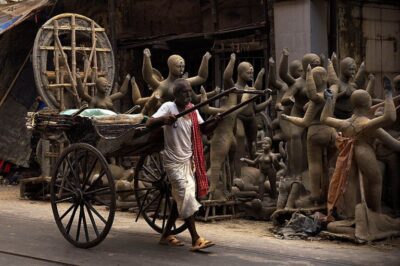
It’s Kumartuli, tightly pressed into the maze-like alleys of North Kolkata, which furtively beats with that strangely sacrosanct rhythm as the festive season nears. Kumartuli neither shines nor wants to modernize sprintingly. Kumartuli works and breathes less than an old craft, idol-making. Known as the potters’ colony, it is much more than just a geographical space; it is a living archive of artistic dedication, filial pride, and pictorial narrative. Every year, as a melt-in-pot of clay, its so simple, clay-splattered lanes transform into a cradle of grandiosity, wherein the artisans not only shape idols, but emotions, hopes, and identities of millions.
The Origin of the colony
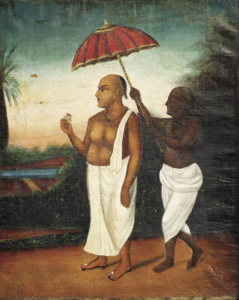
The story of Kumartuli dates back in the 18th century when Bengal soil was as politically volatile as it was fertile. After the British East India Company’s win in the Battle of Plassey which took place in 1757, Raja Nabakrishna Deb of Sobhabazar held a celebratory Durga Puja. He invited the potter from Krishnanagar to make the idol, which incubated into what would later become Kumartuli. But the situation was such that demands were increasingly flood from other wealthy Bengali families. Therefore, there was a permanent settlement made for these artisans, and Kumartuli found itself settled along the banks of the Hooghly.
This locality emerged between Rabindra Sarani and the river; it represents and has been at the nexus between spiritual necessity and artisanal genius. Over the ages, Kumartuli came to signify mastery of clay art, and its kumbhars, the idol-makers, won the patronage of the rich Kolkata families, who made them part of the cultural traditions of Bengal.
How Kumartuli flourished
After starting from humble beginnings, Kumartuli has ebbed past into being a shrine of idol-making, both venerated locally and recognized all around the world. But it was once a settlement of a few huts, making way for a cultural landmark now familiar worldwide so far as idols go—idols that traverse across India and abroad to various parts of USA, UK and Australia, for celebrating Durga Puja with the diaspora.
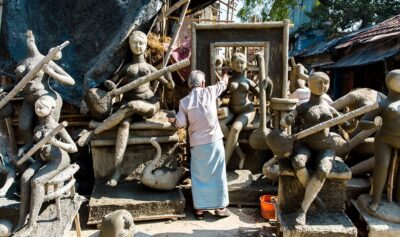
A pulsating ecosystem associates the success of Kumartuli—the artist, straw-weaver, ornament maker, drape-stylist, and painter, forging a rhythmic collaboration in overcrowded but emotionally volatile arenas. These artisans have passed down the skills of their parents and grandparents, working through relentless monsoons, fitful power supply, and hard deadlines, ensuring the deities are finished just in time for their divine arrival. Kumartuli may look like a hotchpotch, but working there is anything but a random process—it’s orchestral, a harmony bred out of centuries of practice.
The community makes a big difference—be it shared techniques or whispered lores or even resource pooling during bad seasons. All this operates under a silent web of support which ties this space together. The further shift of Durga Puja from an elite to a community celebration in the early 20th century only served to elevate the status of Kumartuli. There are presently over 4,000 pujas held across Kolkata today: the demands are titanic, and Kumartuli gallantly meets them every year.
The Current Scenario
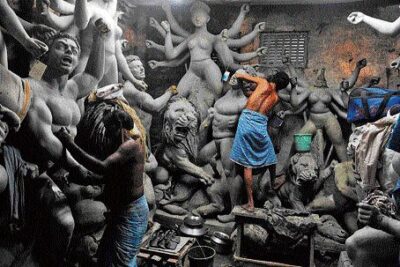
After starting from humble beginnings, Kumartuli has ebbed past into being a shrine of idol-making, both venerated locally and recognized all around the world. But it was once a settlement of a few huts, making way for a cultural landmark now familiar worldwide so far as idols go—idols that traverse across India and abroad to Canada, US, UK, Australia, etc, for celebrating Durga Puja with the diaspora.
A pulsating ecosystem associates the success of Kumartuli—the artist, straw-weaver, ornament maker, drape-stylist, and painter, forging a rhythmic collaboration in overcrowded but emotionally volatile arenas. These artisans have passed down the skills of their parents and grandparents, working through relentless monsoons, fitful power supply, and hard deadlines, ensuring the deities are finished just in time for their divine arrival. Kumartuli may look like a hotchpotch, but working there is anything but a random process—it’s orchestral, a harmony bred out of centuries of practice.
The community makes a big difference—be it shared techniques or whispered lores or even resource pooling during bad seasons. All this operates under a silent web of support which ties this space together. The further shift of Durga Puja from an elite to a community celebration in the early 20th century only served to elevate the status of Kumartuli. There are presently over 4,000 pujas held across Kolkata today: the demands are titanic, and Kumartuli gallantly meets them every year.
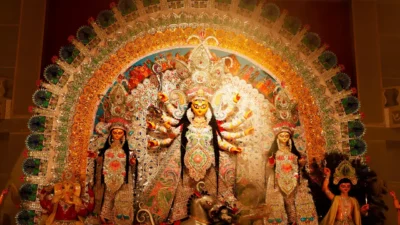
Materials, Motifs, and Meaning
The idol-making process is almost ritualistic here. First of all, a framework of bamboo and straw is laid, on which terracruda is then layered, that is clay not baked but sun-dried. These are then smoothed out using cotton or jute cloth, and painted using natural colors which, nowadays, are mostly replaced with market-bought acrylics.
The eyes of the idol of the goddess are painted in the end in a moment known as ‘Chokkhudaan’- the bestowing of divine vision. It is an emotionally charged act wherein time, skill, and prayer converge into brushstrokes that breathe life into clay.
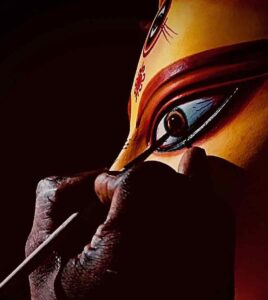
As for decoration, traditional idols used to get adorned with the ‘sholar saaj’- a delicate crown and ornamentation made of pith-and the ‘daker saaj’, made of beaten silver that came from Germany in post. Nowadays, glitter, sequins, velvet saris, and even LED lights help to add a little sparkle as an ensemble.
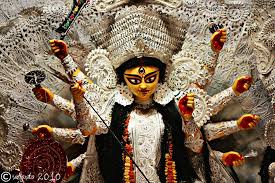
Symbolism is very profound and layered. The goddess rides upon a lion which represents and symbolises strength and courage. She kills Mahishasura, who wreaked havoc upon all gods. Her children-Lakshmi, Saraswati, Ganesh, and Kartik- represent different things.Goddess Lakshmi and Lord Ganesh signify wealth and prosperity. Knowledge is the spirit of Goddess Saraswati and Lord Kartik is represented by valour. This brings together a tableau of ideal human aspirations, which although grounded in ancient myth is very relevant today.
Modern day idols are a representation of the aesthetics and art of the changing society. Mahishasura has been endowed with bodybuilder muscles or villainous Bollywood flair. Durga’s face may resemble that of film stars. Ganesh is depicted reclining like an intellectual, while Saraswati may be pictured bearing a laptop beside her veena. These do not dilute tradition; rather, they reinterpret it and keep the craft alive and relevant.
Conclusion: Where Clay Meets Cosmic Continuity
The neighborhood of Kumartuli is a living metaphor of continuity, reinvention, and devotion in itself. It reminds us that heritage is not about being frozen in time, but rather about molding time, just as the artisans mold clay. Each idol walking out of the enclave bears not just the imprint of the fingers, but also that of faith, memory, and silent prayers murmured between the brushstrokes.
Authenticity often goes hush-hush where commercialization begins, but Kumartuli is a soft yet stern reminder that passion keeps many crafts alive rather than profit. The gods may take on different forms, their drapery sparkle with polyester instead of pith, but the soul that nurtures hope and binds the community together will remain sacred.
Thus, when the next batch of clouds laced with monsoon will stir the smell of wet earth from the potters’ hands, Kumartuli will commence yet another rendezvous with the divine. Clay will be shaped, eyes painted, and somewhere under a tin roof strewn with a solitary bulb, the all-timeless goddess will stir to life.
Bibliography
1.Exploring Kumortuli: Where Sculptures Come To Life In Kolkata. Outlook Traveller
2.Kolkata’s Potters’ Colony: Kumortuli. Sahapedia
3.Journey through Kumartuli. People’s Archive of Rural India
4.How Generations Of Kumartuli’s Artisans Have Crafted A Culture Of Devotion For Durga Puja. Homegrown
5.Dr. Lopamudra Maitra.Durga idols of Kumartuli: Surviving Oral Traditions through Changes. Symbiosis Institute of Media and Communication (SIMC- UG), Pune




